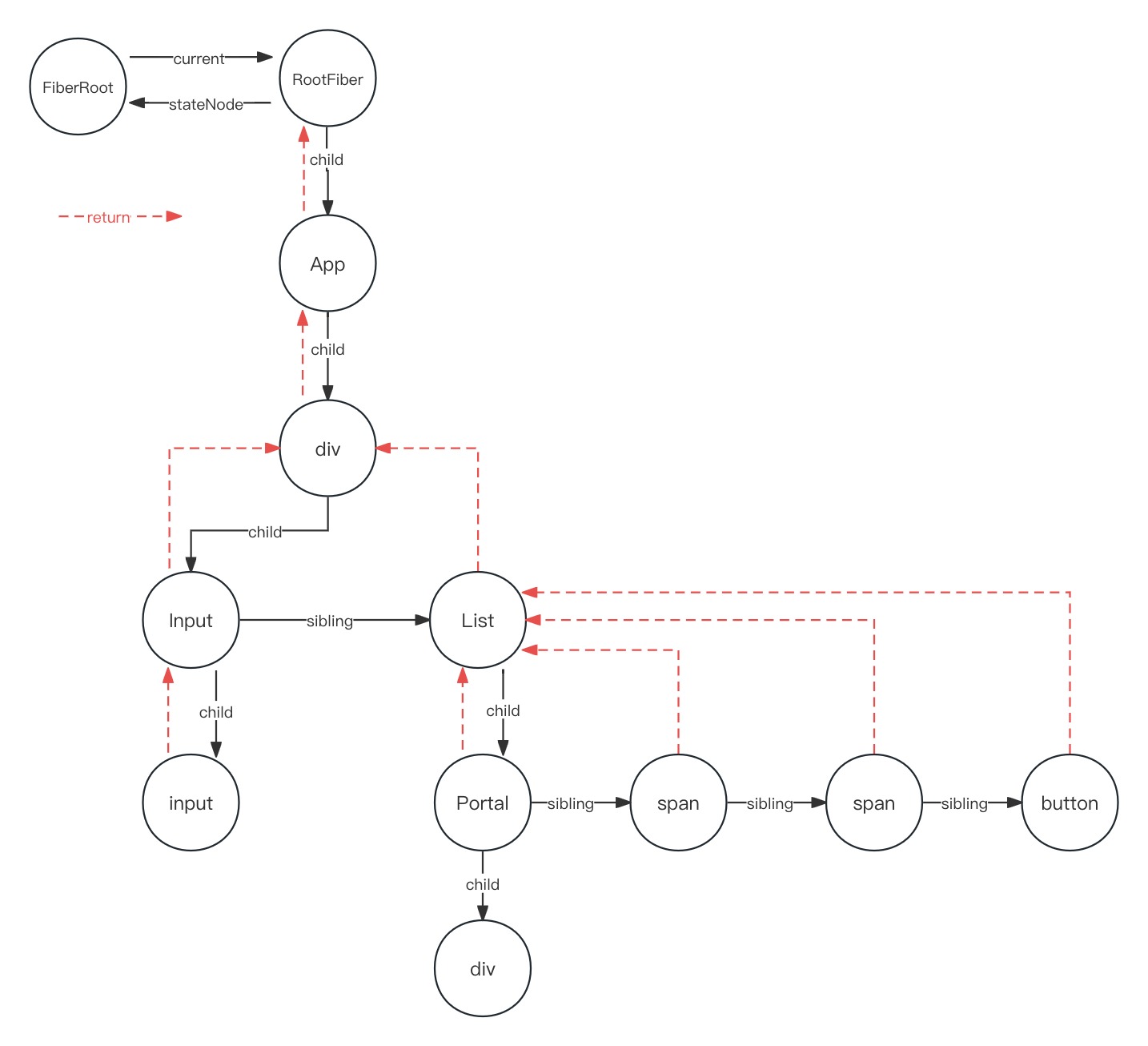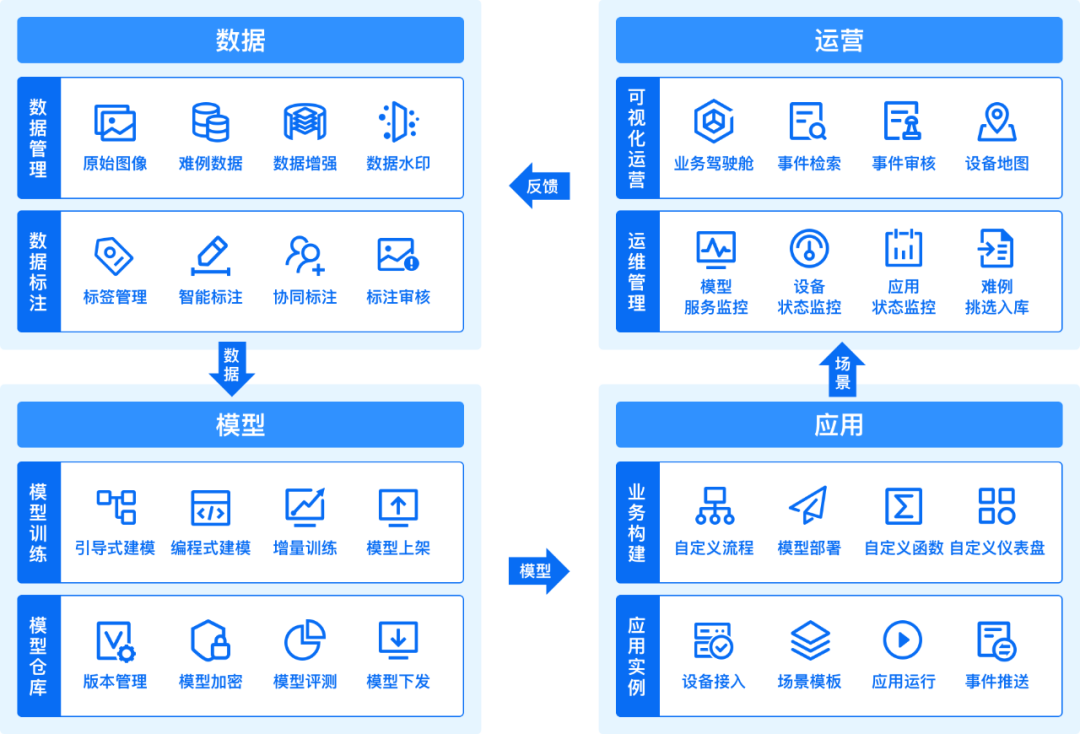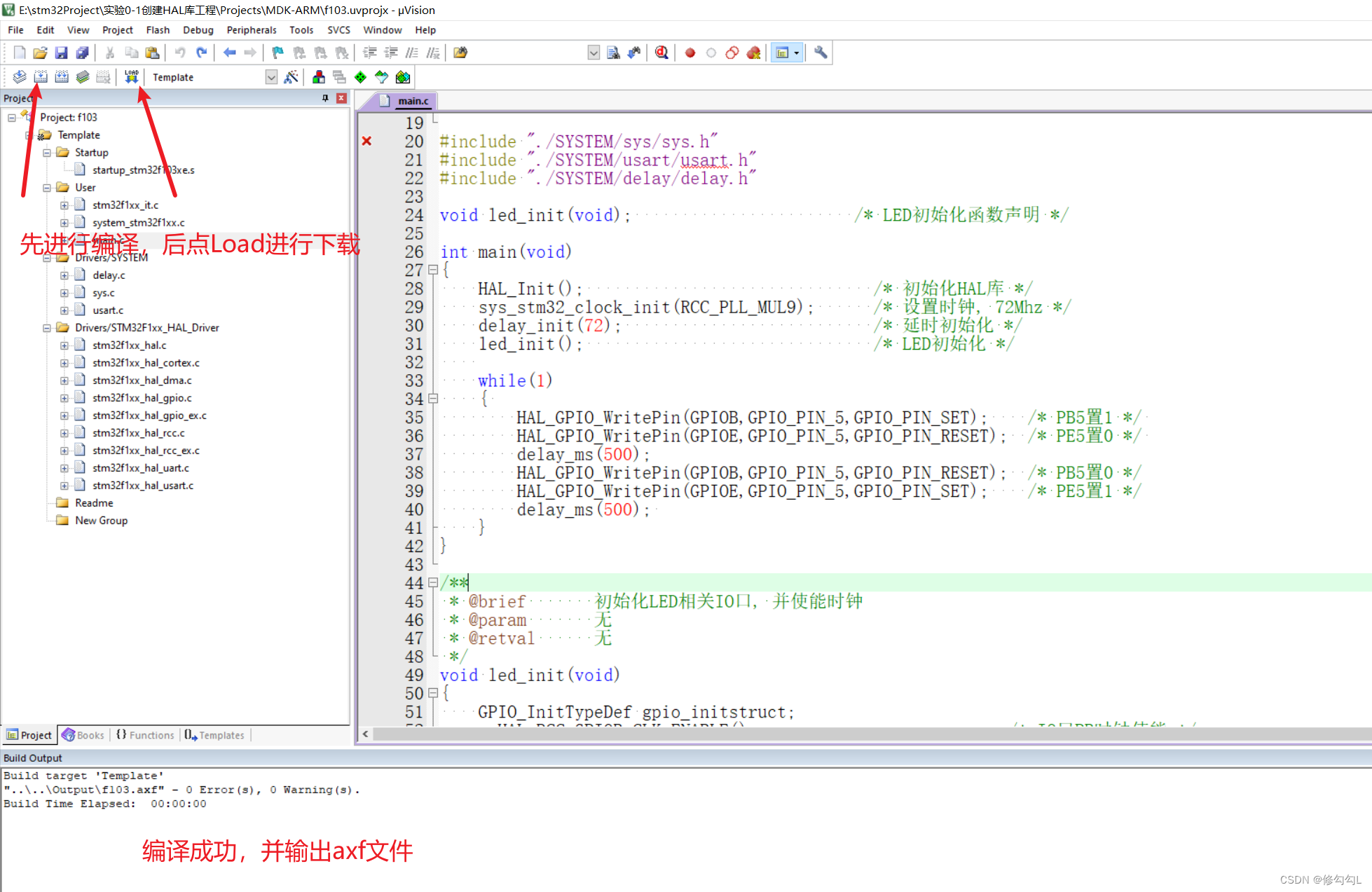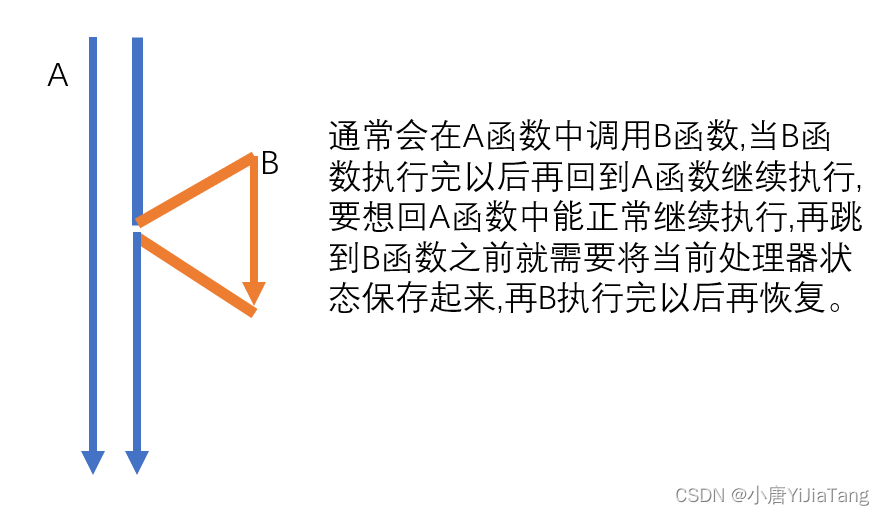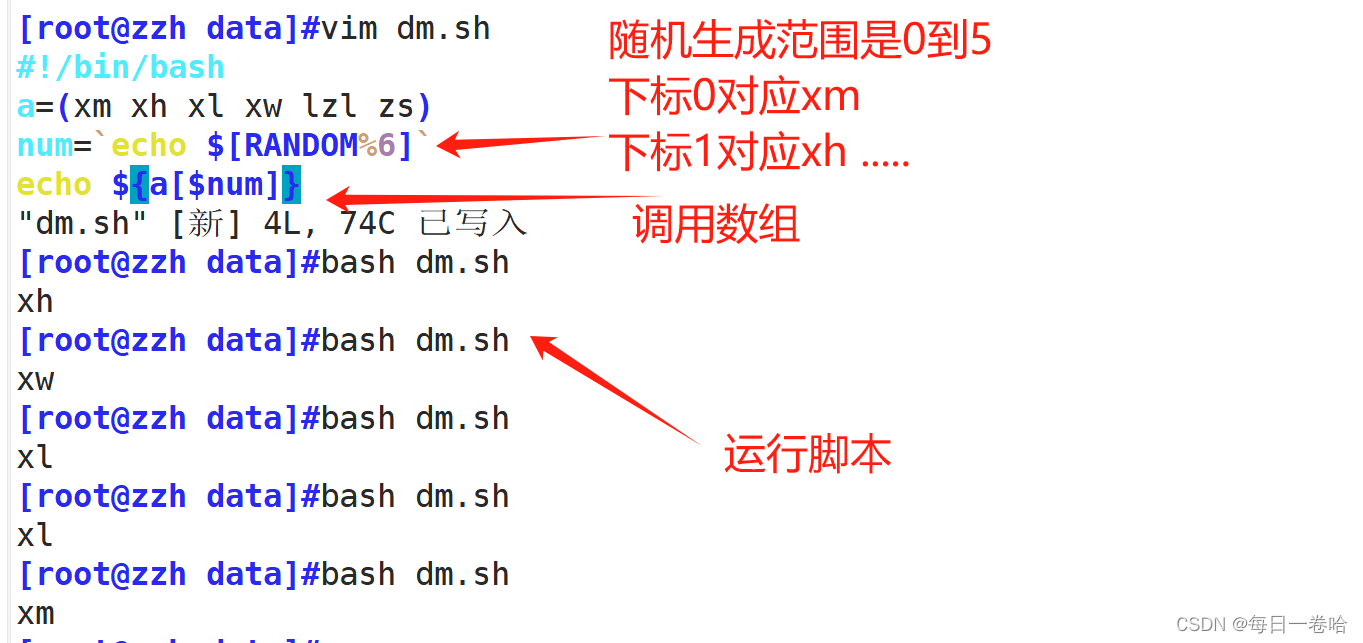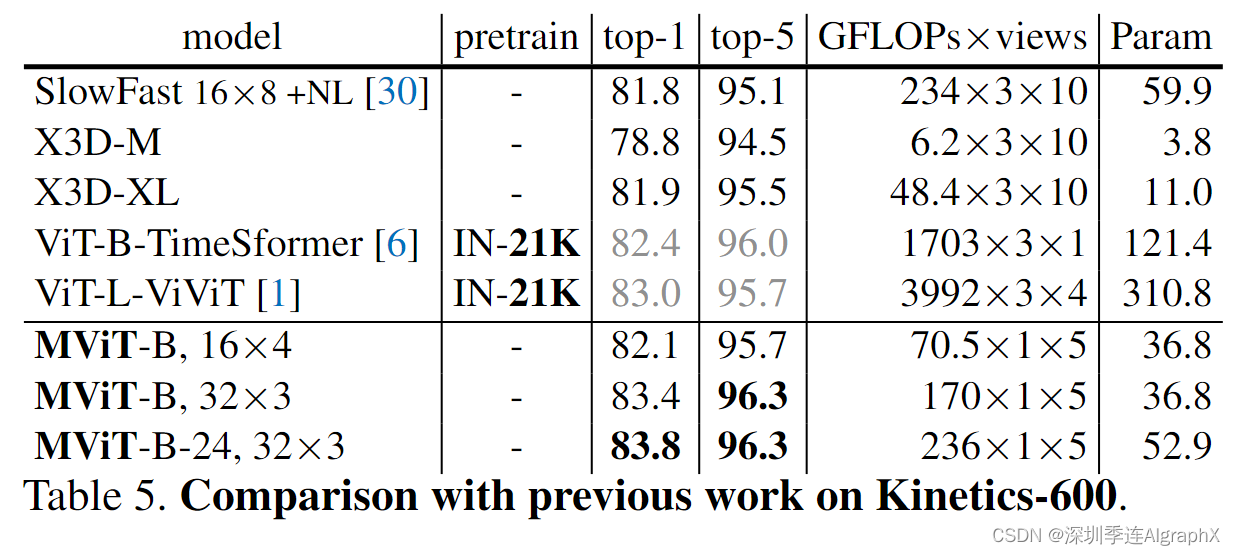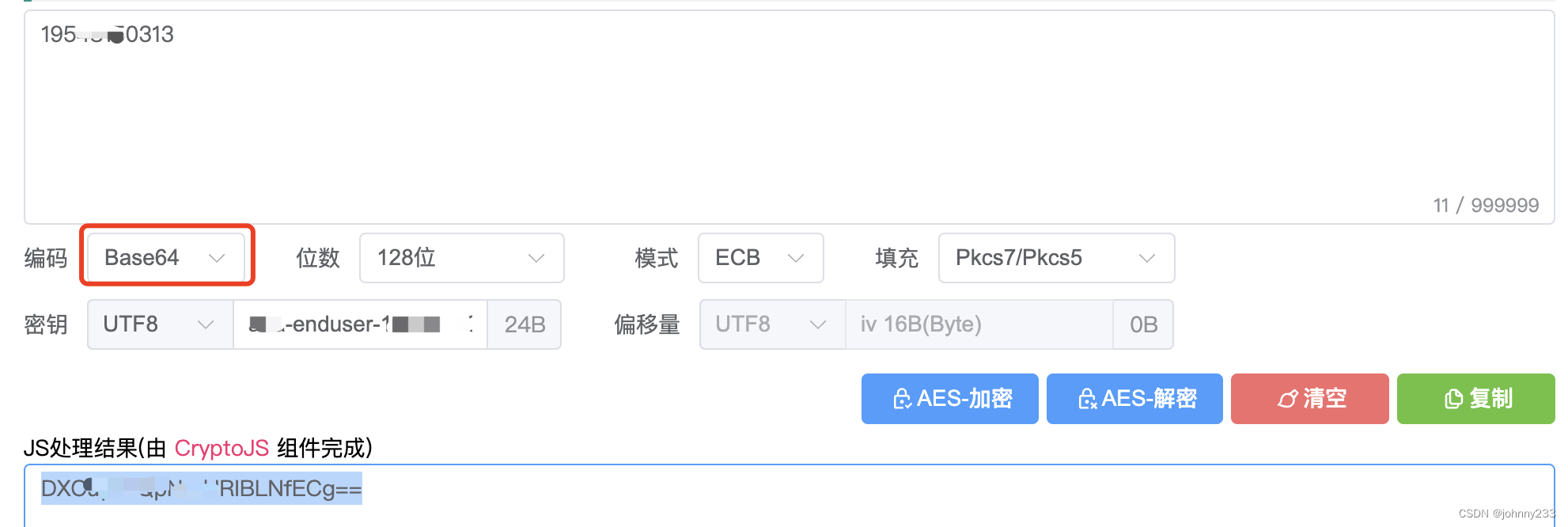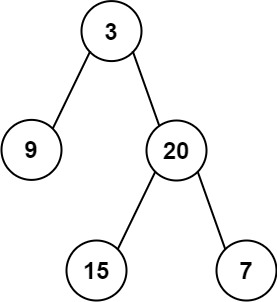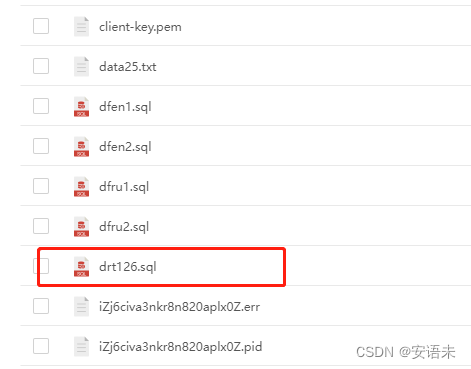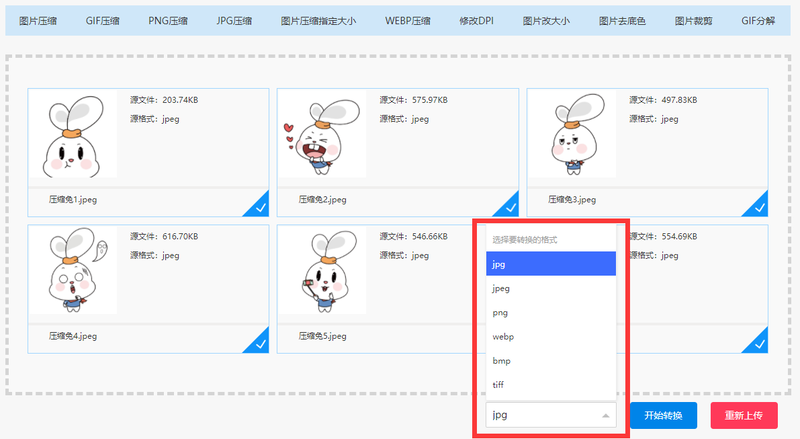时间复杂度
1.链表逆序
package class04;
import java.util.ArrayList;
import java.util.List;
public class Code01_ReverseList {
public static class Node {
public int value;
public Node next;
public Node(int data) {
value = data;
}
}
public static class DoubleNode {
public int value;
public DoubleNode last;
public DoubleNode next;
public DoubleNode(int data) {
value = data;
}
}
public static Node reverseLinkedList(Node head) {
Node pre = null;
Node next = null;
while (head != null) {
next = head.next;
head.next = pre;
pre = head;
head = next;
}
return pre;
}
public static DoubleNode reverseDoubleList(DoubleNode head) {
DoubleNode pre = null;
DoubleNode next = null;
while (head != null) {
next = head.next;
head.next = pre;
head.last = next;
pre = head;
head = next;
}
return pre;
}
public static Node testReverseLinkedList(Node head) {
if (head == null) {
return null;
}
ArrayList<Node> list = new ArrayList<>();
while (head != null) {
list.add(head);
head = head.next;
}
list.get(0).next = null;
int N = list.size();
for (int i = 1; i < N; i++) {
list.get(i).next = list.get(i - 1);
}
return list.get(N - 1);
}
public static DoubleNode testReverseDoubleList(DoubleNode head) {
if (head == null) {
return null;
}
ArrayList<DoubleNode> list = new ArrayList<>();
while (head != null) {
list.add(head);
head = head.next;
}
list.get(0).next = null;
DoubleNode pre = list.get(0);
int N = list.size();
for (int i = 1; i < N; i++) {
DoubleNode cur = list.get(i);
cur.last = null;
cur.next = pre;
pre.last = cur;
pre = cur;
}
return list.get(N - 1);
}
// for test
public static Node generateRandomLinkedList(int len, int value) {
int size = (int) (Math.random() * (len + 1));
if (size == 0) {
return null;
}
size--;
Node head = new Node((int) (Math.random() * (value + 1)));
Node pre = head;
while (size != 0) {
Node cur = new Node((int) (Math.random() * (value + 1)));
pre.next = cur;
pre = cur;
size--;
}
return head;
}
// for test
public static DoubleNode generateRandomDoubleList(int len, int value) {
int size = (int) (Math.random() * (len + 1));
if (size == 0) {
return null;
}
size--;
DoubleNode head = new DoubleNode((int) (Math.random() * (value + 1)));
DoubleNode pre = head;
while (size != 0) {
DoubleNode cur = new DoubleNode((int) (Math.random() * (value + 1)));
pre.next = cur;
cur.last = pre;
pre = cur;
size--;
}
return head;
}
// for test
public static List<Integer> getLinkedListOriginOrder(Node head) {
List<Integer> ans = new ArrayList<>();
while (head != null) {
ans.add(head.value);
head = head.next;
}
return ans;
}
// for test
public static boolean checkLinkedListReverse(List<Integer> origin, Node head) {
for (int i = origin.size() - 1; i >= 0; i--) {
if (!origin.get(i).equals(head.value)) {
return false;
}
head = head.next;
}
return true;
}
// for test
public static List<Integer> getDoubleListOriginOrder(DoubleNode head) {
List<Integer> ans = new ArrayList<>();
while (head != null) {
ans.add(head.value);
head = head.next;
}
return ans;
}
// for test
public static boolean checkDoubleListReverse(List<Integer> origin, DoubleNode head) {
DoubleNode end = null;
for (int i = origin.size() - 1; i >= 0; i--) {
if (!origin.get(i).equals(head.value)) {
return false;
}
end = head;
head = head.next;
}
for (int i = 0; i < origin.size(); i++) {
if (!origin.get(i).equals(end.value)) {
return false;
}
end = end.last;
}
return true;
}
public static void f(Node head) {
head = head.next;
}
// for test
public static void main(String[] args) {
int len = 50;
int value = 100;
int testTime = 100000;
System.out.println("test begin!");
for (int i = 0; i < testTime; i++) {
Node node1 = generateRandomLinkedList(len, value);
List<Integer> list1 = getLinkedListOriginOrder(node1);
node1 = reverseLinkedList(node1);
if (!checkLinkedListReverse(list1, node1)) {
System.out.println("Oops1!");
}
Node node2 = generateRandomLinkedList(len, value);
List<Integer> list2 = getLinkedListOriginOrder(node2);
node2 = testReverseLinkedList(node2);
if (!checkLinkedListReverse(list2, node2)) {
System.out.println("Oops2!");
}
DoubleNode node3 = generateRandomDoubleList(len, value);
List<Integer> list3 = getDoubleListOriginOrder(node3);
node3 = reverseDoubleList(node3);
if (!checkDoubleListReverse(list3, node3)) {
System.out.println("Oops3!");
}
DoubleNode node4 = generateRandomDoubleList(len, value);
List<Integer> list4 = getDoubleListOriginOrder(node4);
node4 = reverseDoubleList(node4);
if (!checkDoubleListReverse(list4, node4)) {
System.out.println("Oops4!");
}
}
System.out.println("test finish!");
}
}2.单链表实现堆区跟队列
package class04;
import java.util.LinkedList;
import java.util.Queue;
import java.util.Stack;
public class Code02_LinkedListToQueueAndStack {
public static class Node<V> {
public V value;
public Node<V> next;
public Node(V v) {
value = v;
next = null;
}
}
public static class MyQueue<V> {
private Node<V> head;
private Node<V> tail;
private int size;
public MyQueue() {
head = null;
tail = null;
size = 0;
}
public boolean isEmpty() {
return size == 0;
}
public int size() {
return size;
}
public void offer(V value) {
Node<V> cur = new Node<V>(value);
if (tail == null) {
head = cur;
tail = cur;
} else {
tail.next = cur;
tail = cur;
}
size++;
}
// C/C++的同学需要做节点析构的工作
public V poll() {
V ans = null;
if (head != null) {
ans = head.value;
head = head.next;
size--;
}
if (head == null) {
tail = null;
}
return ans;
}
// C/C++的同学需要做节点析构的工作
public V peek() {
V ans = null;
if (head != null) {
ans = head.value;
}
return ans;
}
}
public static class MyStack<V> {
private Node<V> head;
private int size;
public MyStack() {
head = null;
size = 0;
}
public boolean isEmpty() {
return size == 0;
}
public int size() {
return size;
}
public void push(V value) {
Node<V> cur = new Node<>(value);
if (head == null) {
head = cur;
} else {
cur.next = head;
head = cur;
}
size++;
}
public V pop() {
V ans = null;
if (head != null) {
ans = head.value;
head = head.next;
size--;
}
return ans;
}
public V peek() {
return head != null ? head.value : null;
}
}
public static void testQueue() {
MyQueue<Integer> myQueue = new MyQueue<>();
Queue<Integer> test = new LinkedList<>();
int testTime = 5000000;
int maxValue = 200000000;
System.out.println("测试开始!");
for (int i = 0; i < testTime; i++) {
if (myQueue.isEmpty() != test.isEmpty()) {
System.out.println("Oops!");
}
if (myQueue.size() != test.size()) {
System.out.println("Oops!");
}
double decide = Math.random();
if (decide < 0.33) {
int num = (int) (Math.random() * maxValue);
myQueue.offer(num);
test.offer(num);
} else if (decide < 0.66) {
if (!myQueue.isEmpty()) {
int num1 = myQueue.poll();
int num2 = test.poll();
if (num1 != num2) {
System.out.println("Oops!");
}
}
} else {
if (!myQueue.isEmpty()) {
int num1 = myQueue.peek();
int num2 = test.peek();
if (num1 != num2) {
System.out.println("Oops!");
}
}
}
}
if (myQueue.size() != test.size()) {
System.out.println("Oops!");
}
while (!myQueue.isEmpty()) {
int num1 = myQueue.poll();
int num2 = test.poll();
if (num1 != num2) {
System.out.println("Oops!");
}
}
System.out.println("测试结束!");
}
public static void testStack() {
MyStack<Integer> myStack = new MyStack<>();
Stack<Integer> test = new Stack<>();
int testTime = 5000000;
int maxValue = 200000000;
System.out.println("测试开始!");
for (int i = 0; i < testTime; i++) {
if (myStack.isEmpty() != test.isEmpty()) {
System.out.println("Oops!");
}
if (myStack.size() != test.size()) {
System.out.println("Oops!");
}
double decide = Math.random();
if (decide < 0.33) {
int num = (int) (Math.random() * maxValue);
myStack.push(num);
test.push(num);
} else if (decide < 0.66) {
if (!myStack.isEmpty()) {
int num1 = myStack.pop();
int num2 = test.pop();
if (num1 != num2) {
System.out.println("Oops!");
}
}
} else {
if (!myStack.isEmpty()) {
int num1 = myStack.peek();
int num2 = test.peek();
if (num1 != num2) {
System.out.println("Oops!");
}
}
}
}
if (myStack.size() != test.size()) {
System.out.println("Oops!");
}
while (!myStack.isEmpty()) {
int num1 = myStack.pop();
int num2 = test.pop();
if (num1 != num2) {
System.out.println("Oops!");
}
}
System.out.println("测试结束!");
}
public static void main(String[] args) {
testQueue();
testStack();
}
}
3.双链表结构实现双端队列
package class04;
import java.util.Deque;
import java.util.LinkedList;
public class Code03_DoubleLinkedListToDeque {
public static class Node<V> {
public V value;
public Node<V> last;
public Node<V> next;
public Node(V v) {
value = v;
last = null;
next = null;
}
}
public static class MyDeque<V> {
private Node<V> head;
private Node<V> tail;
private int size;
public MyDeque() {
head = null;
tail = null;
size = 0;
}
public boolean isEmpty() {
return size == 0;
}
public int size() {
return size;
}
public void pushHead(V value) { //从头部加
Node<V> cur = new Node<>(value);
if (head == null) { //之前没有节点,cur是第一个
head = cur;
tail = cur;
} else {
cur.next = head;
head.last = cur;
head = cur;
}
size++;
}
public void pushTail(V value) {
Node<V> cur = new Node<>(value);
if (head == null) {
head = cur;
tail = cur;
} else {
tail.next = cur;
cur.last = tail;
tail = cur;
}
size++;
}
public V pollHead() { //从头部弹出
V ans = null;
if (head == null) {
return ans;
}
size--;
ans = head.value;
if (head == tail) { //只有一个节点
head = null;
tail = null;
} else {
head = head.next;
head.last = null;
}
return ans;
}
public V pollTail() {
V ans = null;
if (head == null) {
return ans;
}
size--;
ans = tail.value;
if (head == tail) {
head = null;
tail = null;
} else {
tail = tail.last;
tail.next = null;
}
return ans;
}
public V peekHead() {
V ans = null;
if (head != null) {
ans = head.value;
}
return ans;
}
public V peekTail() {
V ans = null;
if (tail != null) {
ans = tail.value;
}
return ans;
}
}
public static void testDeque() {
MyDeque<Integer> myDeque = new MyDeque<>();
Deque<Integer> test = new LinkedList<>();
int testTime = 5000000;
int maxValue = 200000000;
System.out.println("测试开始!");
for (int i = 0; i < testTime; i++) {
if (myDeque.isEmpty() != test.isEmpty()) {
System.out.println("Oops!");
}
if (myDeque.size() != test.size()) {
System.out.println("Oops!");
}
double decide = Math.random();
if (decide < 0.33) {
int num = (int) (Math.random() * maxValue);
if (Math.random() < 0.5) {
myDeque.pushHead(num);
test.addFirst(num);
} else {
myDeque.pushTail(num);
test.addLast(num);
}
} else if (decide < 0.66) {
if (!myDeque.isEmpty()) {
int num1 = 0;
int num2 = 0;
if (Math.random() < 0.5) {
num1 = myDeque.pollHead();
num2 = test.pollFirst();
} else {
num1 = myDeque.pollTail();
num2 = test.pollLast();
}
if (num1 != num2) {
System.out.println("Oops!");
}
}
} else {
if (!myDeque.isEmpty()) {
int num1 = 0;
int num2 = 0;
if (Math.random() < 0.5) {
num1 = myDeque.peekHead();
num2 = test.peekFirst();
} else {
num1 = myDeque.peekTail();
num2 = test.peekLast();
}
if (num1 != num2) {
System.out.println("Oops!");
}
}
}
}
if (myDeque.size() != test.size()) {
System.out.println("Oops!");
}
while (!myDeque.isEmpty()) {
int num1 = myDeque.pollHead();
int num2 = test.pollFirst();
if (num1 != num2) {
System.out.println("Oops!");
}
}
System.out.println("测试结束!");
}
public static void main(String[] args) {
testDeque();
}
}
4.k个节点的组内逆序调整
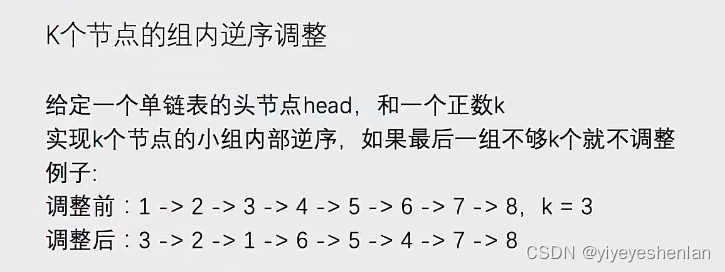
reverse函数


package class04;
// 测试链接:https://leetcode.com/problems/reverse-nodes-in-k-group/
public class Code04_ReverseNodesInKGroup {
// 不要提交这个类
public static class ListNode {
public int val;
public ListNode next;
}
public static ListNode reverseKGroup(ListNode head, int k) {
ListNode start = head;
ListNode end = getKGroupEnd(start, k);
if (end == null) { //第一组小于k个
return head;
}
// 第一组凑齐了!
head = end; //以后head不动了
reverse(start, end);
// 上一组的结尾节点
ListNode lastEnd = start;
while (lastEnd.next != null) {
start = lastEnd.next;
end = getKGroupEnd(start, k);
if (end == null) {
return head;
}
reverse(start, end);
lastEnd.next = end;
lastEnd = start;
}
return head;
}
//设一个函数,给你开始节点,数够k个,把第k个返回
public static ListNode getKGroupEnd(ListNode start, int k) {
while (--k != 0 && start != null) { //&前面--k!=0,指针往后走,&后面是不够k个返回空
start = start.next; //
}
return start;
}
//
public static void reverse(ListNode start, ListNode end) {
end = end.next;
ListNode pre = null;
ListNode cur = start;
ListNode next = null;
while (cur != end) { //到end才停,所以第一步end先往后跳一格
next = cur.next;
cur.next = pre;
pre = cur;
cur = next;
}
start.next = end;
}
}
5.两个链表相加
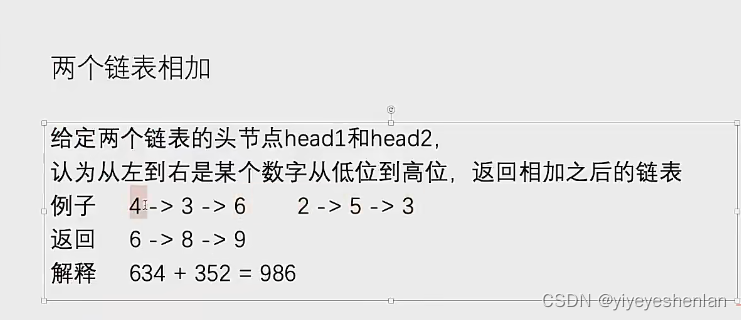
package class04;
// 测试链接:https://leetcode.com/problems/add-two-numbers/
public class Code05_AddTwoNumbers {
// 不要提交这个类
public static class ListNode {
public int val;
public ListNode next;
public ListNode(int val) {
this.val = val;
}
public ListNode(int val, ListNode next) {
this.val = val;
this.next = next;
}
}
public static ListNode addTwoNumbers(ListNode head1, ListNode head2) {
int len1 = listLength(head1);
int len2 = listLength(head2);
//长链表归l,短链表归s
ListNode l = len1 >= len2 ? head1 : head2;
ListNode s = l == head1 ? head2 : head1;
ListNode curL = l;
ListNode curS = s;
ListNode last = curL;
int carry = 0; //单独开一个,储存进位信息(0/1)
int curNum = 0;
while (curS != null) { //第一阶段长链表短链表都有
curNum = curL.val + curS.val + carry; //当前位置的值
curL.val = (curNum % 10);
carry = curNum / 10;
last = curL; //last记录最后一个不空的节点(备份),直到第三阶段
curL = curL.next;
curS = curS.next;
}
while (curL != null) { 第二阶段,短链表没了
curNum = curL.val + carry;
curL.val = (curNum % 10);
carry = curNum / 10;
last = curL;
curL = curL.next;
}
if (carry != 0) { 第二阶段,长短链表都没了
last.next = new ListNode(1);
}
return l; //把两个链表相加之后的结果覆盖到原来的长链表中,也可以在单独开一个链表储存相加之后的额结果
}
// 求链表长度
public static int listLength(ListNode head) {
int len = 0;
while (head != null) {
len++;
head = head.next;
}
return len;
}
}
6.两个有序链表的合并
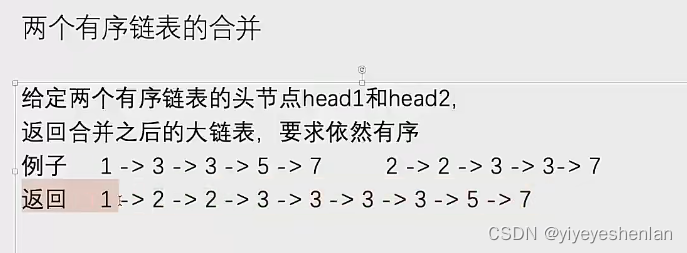
package class04;
// 测试链接:https://leetcode.com/problems/merge-two-sorted-lists
public class Code06_MergeTwoSortedLinkedList {
// 不要提交这个类
public static class ListNode {
public int val;
public ListNode next;
}
public static ListNode mergeTwoLists(ListNode head1, ListNode head2) {
if (head1 == null || head2 == null) {
return head1 == null ? head2 : head1;
}
ListNode head = head1.val <= head2.val ? head1 : head2; //小的做总头
ListNode cur1 = head.next;
ListNode cur2 = head == head1 ? head2 : head1;
ListNode pre = head;
while (cur1 != null && cur2 != null) {
if (cur1.val <= cur2.val) {
pre.next = cur1; //pre的指向,谁小指谁
cur1 = cur1.next; //谁小谁往下走
} else {
pre.next = cur2;
cur2 = cur2.next;
}
pre = pre.next;
}
pre.next = cur1 != null ? cur1 : cur2;
return head;
}
}